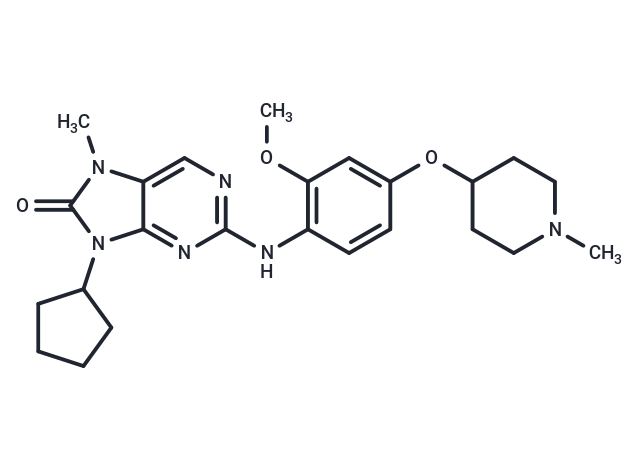Shopping Cart
Remove All Your shopping cart is currently empty
Your shopping cart is currently empty
AZ3146 is a selective Mps1 inhibitor with IC50 of ~35 nM.

| Pack Size | Price | USA Warehouse | Global Warehouse | Quantity |
|---|---|---|---|---|
| 2 mg | $35 | In Stock | In Stock | |
| 5 mg | $57 | In Stock | In Stock | |
| 10 mg | $90 | In Stock | In Stock | |
| 25 mg | $163 | In Stock | In Stock | |
| 50 mg | $270 | In Stock | In Stock | |
| 100 mg | $486 | In Stock | In Stock | |
| 1 mL x 10 mM (in DMSO) | $67 | In Stock | In Stock |
| Description | AZ3146 is a selective Mps1 inhibitor with IC50 of ~35 nM. |
| Targets&IC50 | Mps1:35 nM |
| In vivo | AZ3146 does not affect the mitosis-specific phosphorylated forms of Aurora B and BubR1. When HeLa cells were treated with nocodazole and 2 μM AZ3146, mitosis was briefly delayed before cells resumed genome replication, indicating that AZ3146 can override the Spindle Assembly Checkpoint (SAC). Notably, 90% of AZ3146-treated HeLa cells exhibited abnormal mitosis, with ~50% of cells entering late mitosis failing to correct their chromosomes and ~30% completing mitosis without apparent chromosome segregation. AZ3146 also inhibits FAK, JNK1, JNK2, and Kit, and significantly reduces Mps1 phosphorylation in cells. Furthermore, AZ3146 inhibits established SAC signaling, as evident from the facilitated conclusion of mitosis after release from nocodazole block, and significantly impacts the kinetochore localization of Mad2, reducing it to ~15%, but does not significantly affect Mad1, which remains at ~60%. Before mitosis, Mps1 inhibition by AZ3146 blocks the accumulation of Mad1 and Mad2 at the kinetochore. However, if Mps1 is inhibited by AZ3146 after entering mitosis, the Mad1-C-Mad2 core complex still binds to the kinetochore, but O-Mad2 cannot accumulate at the core. In other undisturbed mitoses, AZ3146 reduces the time to complete mitosis from 90 minutes in the control group to 32 minutes. |
| Kinase Assay | His-tagged human Mps1Cat encoding amino acids 510-857 is generated. For kinase assays, 500 ng is added to buffer (25 mM Tris-HCl, pH 7.4, 100 mM NaCl, 50 μg/mL BSA, 0.1 mM EGTA, 0.1% β-mercaptoethanol, 10 mM MgCl2, and 0.5 μg/mL myelin basic protein), AZ3146, and 100 μM γ-[32P]ATP (2 μCi/assay). Reactions are incubated at 30°C for 20 min, spotted onto P81 paper, washed in 0.5% phosphoric acid, and immersed in acetone. Phosphate incorporation is determined by scintillation counting. For immunoprecipitation kinase assays, HeLa cells are treated with nocodazole for 14 h, mitotic cells isolated, washed in PBS, and lysed for 30 min in 50 mM Tris-HCl, pH 7.4, 100 mM NaCl, 0.5% NP-40, 5 mM EDTA, 5 mM EGTA, 40 mM β-glycerophosphate, 0.2 mM PMSF, 1 mM DTT, 1 mM sodium orthovanadate, 20 mM sodium fluoride, 1 μM okadaic acid, and complete EDTA-free protease inhibitor cocktail. Full-length Mps1 is immunoprecipitated. Purified complexes are washed with lysis buffer containing 100 mM NaCl and assayed as described for the recombinant protein. To quantify 32P incorporation, reactions are stopped with SDS sample buffer and separated by SDS-PAGE followed by phosphorimaging. The plate is analyzed using a phosphorimager using AIDA software. To assess the specificity of AZ3146, a single-point screen is carried using kinase profiling service. 50 kinases are selected and assayed with 1 μM AZ3146[1]. |
| Cell Research | AZ3146 is disolved in DMSO (100 mM) and diluted into 100 μM, 10 μM, 1 μM and 0.1 μM sequentially with DMEM containing 10% FBS before use[2]. The TTK inhibitor AZ3146 is disolved in DMSO at a concentration in 100 mM and diluted into 100 μM, 10 μM, 1 μM and 0.1 μM sequentially with DMEM containing 10% FBS before use. In vitrocytotoxicity assays are performed. HCC cells are plated into 96-well plates at the density of 3×103 per well. AZ3146 is added in the indicated concentrations the next day. The inhibitor treated cells are cultured and tested at a 24-hour intervals for 3-4 days using CCK-8[2]. |
| Synonyms | AZ 3146 |
| Molecular Weight | 452.55 |
| Formula | C24H32N6O3 |
| Cas No. | 1124329-14-1 |
| Smiles | O=C1N(C=2C(N1C)=CN=C(NC3=C(OC)C=C(OC4CCN(C)CC4)C=C3)N2)C5CCCC5 |
| Relative Density. | 1.279 g/cm3 |
| Color | White |
| Appearance | Solid |
| Storage | Powder: -20°C for 3 years | In solvent: -80°C for 1 year | Shipping with blue ice/Shipping at ambient temperature. | |||||||||||||||||||||||||||||||||||
| Solubility Information | DMSO: 11.3 mg/mL (24.97 mM), Sonication is recommended. Ethanol: 33.9 mg/mL (74.91 mM), Sonication is recommended. | |||||||||||||||||||||||||||||||||||
| In Vivo Formulation | 10% DMSO+40% PEG300+5% Tween 80+45% Saline: 2 mg/mL (4.42 mM), Sonication is recommended. Please add the solvents sequentially, clarifying the solution as much as possible before adding the next one. Dissolve by heating and/or sonication if necessary. Working solution is recommended to be prepared and used immediately. The formulation provided above is for reference purposes only. In vivo formulations may vary and should be modified based on specific experimental conditions. | |||||||||||||||||||||||||||||||||||
Solution Preparation Table | ||||||||||||||||||||||||||||||||||||
DMSO/Ethanol
Ethanol
| ||||||||||||||||||||||||||||||||||||
| Size | Quantity | Unit Price | Amount | Operation |
|---|

Copyright © 2015-2025 TargetMol Chemicals Inc. All Rights Reserved.